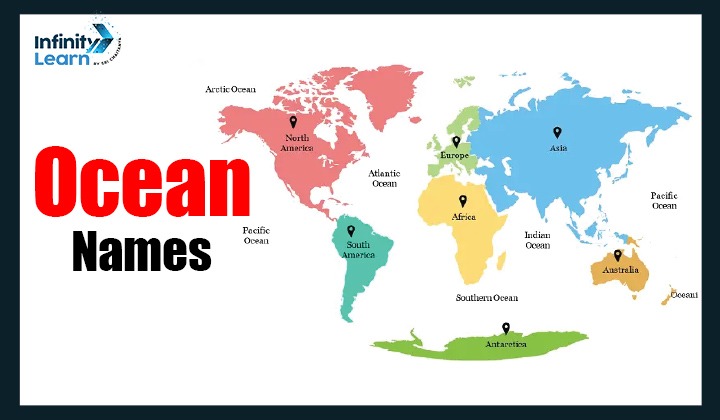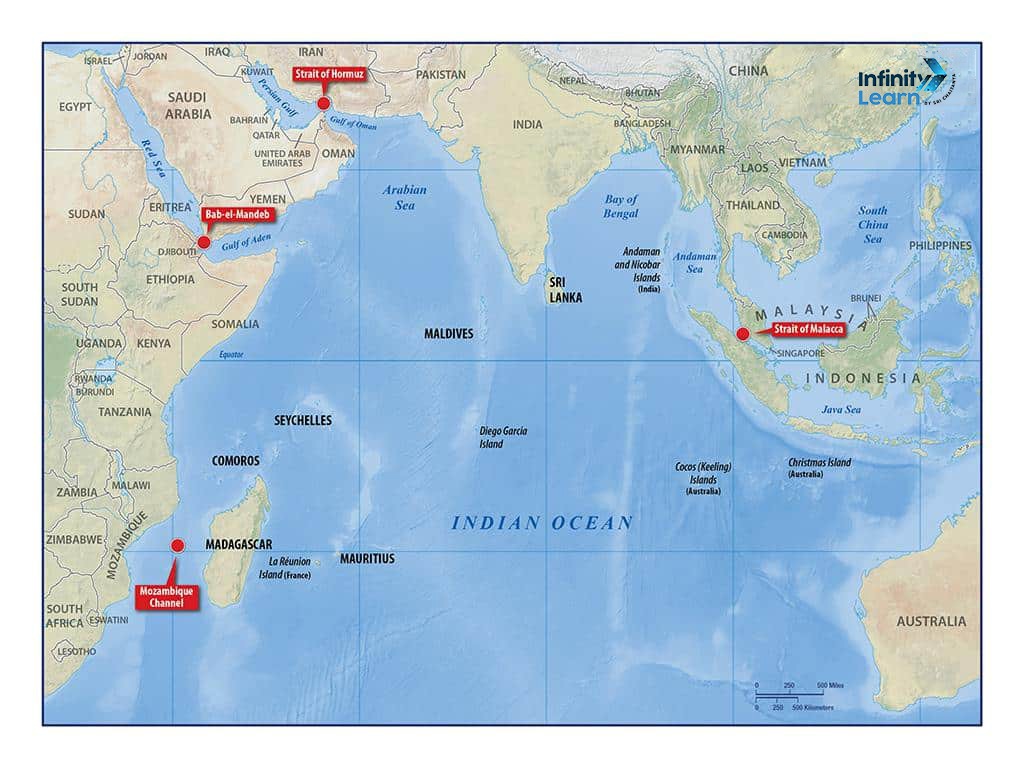Table of Contents
What are the five oceans of the Earth? The global ocean system consists of the Pacific Ocean, Atlantic Ocean, Indian Ocean, Southern Ocean, and Arctic Ocean. These vast bodies of saltwater and brine cover approximately 71% of Earth’s surface. From the shoreline to the deep-water trenches, oceans regulate our climate through currents, support marine biodiversity from plankton to whales, and facilitate international shipping across the high seas.
The Five Oceans: Important Details
| Ocean Name | Location | Key Features | Famous Seas & Gulfs |
| Pacific Ocean | Between Asia/Australia and the Americas | Largest and deepest ocean, Ring of Fire, coral reefs | South China Sea, Tasman Sea, Yellow Sea |
| Atlantic Ocean | Between Americas and Europe/Africa | Second-largest, Gulf Stream current, extensive continental shelf | Mediterranean Sea, Caribbean Sea, Sargasso Sea |
| Indian Ocean | South of Asia, between Africa and Australia | Warmest ocean, monsoon influence, major shipping routes | Red Sea, Arabian Sea, Bay of Bengal |
| Southern Ocean | Surrounding Antarctica | Antarctic Circumpolar Current, icebergs | Weddell Sea, Ross Sea |
| Arctic Ocean | Around the North Pole | Smallest ocean, sea ice coverage | Barents Sea, Beaufort Sea |
5 Ocean Name, Size and Depth Comparison
| Ocean | Surface Area (million km²) | % of Earth’s Surface | Average Depth (m) | Maximum Depth (m) | Volume (million km³) |
| Pacific | 168.72 | 33.1% | 4,280 | 10,924 (Mariana Trench) | 710.0 |
| Atlantic | 85.13 | 16.7% | 3,646 | 8,486 (Puerto Rico Trench) | 310.4 |
| Indian | 70.56 | 13.8% | 3,741 | 7,450 (Java Trench) | 264.0 |
| Southern | 21.96 | 4.3% | 3,270 | 7,235 (South Sandwich Trench) | 71.8 |
| Arctic | 15.56 | 3.1% | 1,205 | 5,567 (Molloy Deep) | 18.8 |
Ocean Ecosystems and Biodiversity
| Ecosystem | Location | Key Species | Environmental Threats |
| Coral Reefs | Pacific, Indian, Caribbean Sea | Coral polyps, reef fish, marine invertebrates | Coral bleaching, ocean acidification |
| Kelp Forests | Pacific coast, Southern Ocean | Kelp, sea otters, fish, invertebrates | Ocean warming, sea urchin overgrazing |
| Deep Sea | All oceans’ deepwater regions | Bioluminescent organisms, giant squid | Deep-sea mining, pollution |
| Continental Shelf | All ocean shorelines | Commercial fish species, shellfish | Overfishing, habitat destruction |
| Pelagic Zone | Open waters of all oceans | Plankton, tuna, sharks, whales | Plastic pollution, climate change |
Pacific Ocean: The Largest Oceanic Expanse
The Pacific Ocean dominates Earth’s surface with depths including the Mariana Trench—the deepest point in the ocean at 10,924 meters. Deep-sea exploration in the Pacific Ocean has revealed extraordinary features like underwater volcanoes and hydrothermal vents. The Pacific basin features extensive coral reefs, including the Great Barrier Reef where scientists monitor coral bleaching due to rising temperatures.
How do ocean currents affect climate? The Pacific demonstrates this through the El Niño phenomenon, which influences global weather patterns. During El Niño events, changes in ocean temperatures disrupt rainfall and temperatures across multiple continents.
Atlantic Ocean:
The Atlantic Ocean features a distinctive continental shelf along much of its coast. Its defining geological feature is the Mid-Atlantic Ridge, where new oceanic crust forms through volcanic activity. The Atlantic plays a crucial role in climate regulation through the Gulf Stream, which transports warm tropical waters northward.
The ebb tide and flow between high tide and low tide create tide pools along Atlantic shorelines, revealing fascinating miniature ecosystems. Differences between Atlantic and Pacific Oceans include the Atlantic’s narrower width, warmer average temperature, and higher salinity.
Indian Ocean:
Where is the Indian Ocean located? The Indian Ocean is bounded by the eastern coast of Africa, southern Asia including the Arabian Peninsula and Indian subcontinent, the Malay Archipelago, and western Australia. It holds the distinction of being the warmest ocean basin.
Marine biodiversity in the Indian Ocean is extraordinary, with the waters surrounding the Maldives, Seychelles, and Andaman Islands supporting thousands of fish species, hundreds of coral varieties, and numerous marine mammals. The region’s inlets, estuaries, and lagoons provide protective habitats for juvenile fish.
Antarctica’s Ocean
The Southern Ocean encircles Antarctica, including the famous Weddell Sea. How do scientists study ocean ecosystems in such extreme environments? Research vessels brave frigid conditions to collect data on unique characteristics, including the powerful Antarctic Circumpolar Current.
The dynamic ice environment creates specialized habitats for penguins, seals, and whales. From an environmental perspective, the Southern Ocean serves as a critical carbon sink, though effects of plastic pollution on oceans reach even these remote waters.
Arctic Ocean:
The Arctic Ocean, Earth’s smallest oceanic division, circles the North Pole with generally shallower depths than other oceans. Arctic Ocean facts for kids include its unique status as an ocean that remains partially frozen throughout the year, though climate change is rapidly reducing this ice coverage.
Climate change has dramatic effects on the Arctic, with warming occurring at twice the global average rate. This affects species like polar bears that depend on sea ice for hunting. The potential opening of new shipping routes through previously ice-covered regions raises both economic opportunities and environmental concerns.
Ocean Phenomena: Tides, Tsunamis, and Underwater Features
| Phenomenon | Description | Notable Examples | Human Impact |
| Tides | Gravitational pull of moon and sun creating high tide/low tide cycles | Bay of Fundy (highest tides) | Navigation, coastal development |
| Tsunamis | Massive waves caused by underwater disturbances | 2004 Indian Ocean, 2011 Tōhoku | Coastal devastation |
| Underwater Volcanoes | Submarine eruptions creating new seafloor | Hawaii formation, Krakatoa | Island creation, tsunamis |
| Ocean Currents | Continuous directed water movement | Gulf Stream, Kuroshio | Climate regulation, navigation |
| Dead Zones | Areas with too little oxygen to support life | Gulf of Mexico, Baltic Sea | Fishery collapse, ecosystem damage |
Ocean Tourism and Recreation Activities
| Activity | Popular Locations | Equipment | Environmental Impact |
| Scuba Diving | Caribbean Sea, Great Barrier Reef | Tanks, buoyancy control | Coral damage if not careful |
| Surfing | Pacific coast (Hawaii, California) | Surfboard | Minimal |
| Whale Watching | Arctic waters, Indian Ocean | Boats, binoculars | Noise pollution, harassment |
| Fishing Charters | All oceans | Fishing gear, boats | Overfishing if not regulated |
| Sailing | Mediterranean Sea, Caribbean | Sailboats, nautical charts | Low when proper waste disposal |
| Kayaking | California bays, coastal inlets | Kayaks, paddles | Minimal |
| Cruising | Caribbean, Mediterranean, Alaska | Cruise ships | Waste, emissions, coral damage |
Ocean Environmental Challenges
Coral bleaching in the Great Barrier Reef occurs when rising ocean temperatures cause coral polyps to expel their symbiotic algae. Overfishing impact on global oceans includes depleted fish stocks, disrupted marine food webs, and damaged habitats from destructive fishing practices.
How to reduce ocean pollution at home:
- Avoid single-use plastics
- Properly dispose of hazardous materials
- Use ocean-friendly cleaning products
- Conserve water
- Support sustainable seafood choices
Organizations working to save the oceans include Ocean Conservancy, The Ocean Cleanup, Oceana, and Sea Shepherd.
Educational Facts About Oceans
Why is the ocean salty? Explained for kids: Oceans contain dissolved minerals, primarily sodium and chloride, that have accumulated over billions of years as rain water erodes rocks and carries minerals to the sea. Unlike lakes, oceans have no outlets, so these salts concentrate over time.
Fun facts about oceans for school projects:
- Oceans cover 71% of Earth’s surface
- Scientists have mapped more of Mars than Earth’s ocean floor
- The ocean contains 97% of Earth’s water
- More than 80% of our ocean remains unexplored
- One drop of seawater contains millions of bacterial cells
Importance of oceans for Earth’s ecosystem:
- Produce over 50% of the world’s oxygen
- Regulate climate by absorbing heat
- Support 80% of the planet’s biodiversity
- Provide food for billions of people
- Protect coastlines from storms
The Earth’s major oceans—Pacific, Atlantic, Indian, Southern, and Arctic—form an interconnected global system supporting life on our blue planet. From deep water trenches to coastal shorelines, from coral reefs to kelp forests, these five oceans regulate our climate, provide resources, and inspire cultural traditions worldwide.
As climate change, plastic pollution, and overfishing threaten these vital ecosystems, understanding ocean science becomes increasingly important. Whether you’re planning to visit the best oceanfront resorts in the Maldives, researching stories of mermaids in ocean folklore, or simply curious about how tides work in oceans, deepening your knowledge of Earth’s five oceans connects you to our planet’s greatest natural feature.
Ocean Names

The Earth’s surface is predominantly covered by oceans, which are essential for regulating climate and supporting marine life. There are five primary oceans recognized globally, each with distinct characteristics.
Oceans Name in English
- Pacific Ocean
- Atlantic Ocean
- Indian Ocean
- Southern Ocean
- Arctic Ocean
Also Read: Southern Ocean – Location, Map, & Facts
7 Ocean Name
Traditionally, the world’s oceans are classified into five major oceans. However, some sources may include the “Antarctic Ocean” as a separate entity, making it seven:
- Pacific Ocean
- Atlantic Ocean
- Indian Ocean
- Southern Ocean
- Arctic Ocean
- Antarctic Ocean (sometimes considered separately)
- Antarctic Ocean (if split from Southern Ocean)
Name the Oceans of the World
The primary oceans of the world are:
- Pacific Ocean
- Atlantic Ocean
- Indian Ocean
- Southern Ocean
- Arctic Ocean
7 Continents and 5 Oceans Name
Here’s the information on 7 continents and 5 oceans names in table format:
| Continents | Description |
|---|---|
| Asia | The largest continent by area and population. |
| Africa | Known for its diverse cultures and natural resources. |
| North America | Home to the USA, Canada, and Mexico. |
| South America | Famous for the Amazon Rainforest and Andes Mountains. |
| Antarctica | The icy continent at the South Pole, largely uninhabited. |
| Europe | Known for its historical influence and diverse cultures. |
| Australia | The smallest continent, also referred to as Oceania. |
| Oceans | Description |
| Pacific Ocean | The largest and deepest ocean, over 63 million square miles. |
| Atlantic Ocean | The second-largest ocean, separating the Americas from Europe and Africa. |
| Indian Ocean | Located between Africa, Asia, Australia, and the Indian subcontinent. |
| Southern Ocean | Encircles Antarctica and is known for its unique marine life. |
| Arctic Ocean | The smallest and shallowest ocean, located around the Arctic region |
Name All the Oceans
- Pacific Ocean
- Atlantic Ocean
- Indian Ocean
- Southern Ocean
- Arctic Ocean
7 Oceans Name in Hindi
- प्रशांत महासागर (Pacific Ocean)
- अटलांटिक महासागर (Atlantic Ocean)
- भारतीय महासागर (Indian Ocean)
- दक्षिणी महासागर (Southern Ocean)
- आर्कटिक महासागर (Arctic Ocean)
- अंटार्कटिक महासागर (Antarctic Ocean)
- अंटार्कटिक महासागर (Antarctic Ocean)
Also Read: Indian Ocean – Features, Depth, and Fascinating Facts
Ocean Name in India
The primary ocean associated with India is the Indian Ocean, which is named after the Indian subcontinent.
World Biggest Ocean Name
The Pacific Ocean is the largest ocean in the world, covering more than 63 million square miles.
Why Is Indian Ocean Named After Our Country?
The Indian Ocean is named after the Indian subcontinent due to its significant geographical location and historical importance in trade routes and cultural exchanges.
Write the Name of Continents and Oceans
The continents are Asia, Africa, North America, South America, Antarctica, Europe, and Australia. The oceans are the Pacific, Atlantic, Indian, Southern, and Arctic Oceans.
Name the Oceans in Increasing Order of Their Size
- Arctic Ocean
- Southern Ocean
- Indian Ocean
- Atlantic Ocean
- Pacific Ocean
Ocean Names for Babies
Choosing an ocean-inspired name for your baby can symbolize depth, strength, and tranquility, much like the vast and mysterious seas. Whether drawn from mythology, different cultures, or the natural beauty of water bodies, these names carry a serene yet powerful essence. Here are 10 beautiful ocean names for babies in English and Hindi, inspired by the boundless spirit of the sea.
| English Name | Meaning | Hindi Name (हिंदी नाम) | अर्थ |
| Maris | Latin for “of the sea” | सागरिका (Sagarika) | समुद्र की बेटी |
| Kai | Hawaiian for “sea” | जल (Jal) | पानी, समुद्र |
| Darya | Persian for “sea” | दरिया (Dariya) | नदी, महासागर |
| Ocean | Inspired by the vast oceans | महासागर (Mahasagar) | विशाल समुद्र |
| Mira | Sanskrit for “ocean, sea” | नीरा (Neera) | शुद्ध जल |
| Caspian | Named after the Caspian Sea | कास्पियन (Kaspiyan) | कास्पियन सागर से प्रेरित |
| River | Inspired by water bodies | नदी (Nadi) | प्रवाहमान जल |
| Nautica | Related to the sea and navigation | नाव्या (Navya) | नौकायन से जुड़ा |
| Marina | Latin for “from the sea” | समुद्री (Samudri) | समुद्र से संबंधित |
| Blue | Inspired by the ocean’s color | नील (Neel) | गहरा नीला, समुद्र का रंग |
Geopolitical Ocean Name Changes
Oceans and seas are not just large water bodies; they play a crucial role in trade, politics, and history. Over time, some oceanic regions and straits have been renamed or debated due to cultural, historical, and political reasons. These changes often reflect a country’s influence or identity in a global context.
For example, important waterways like the Strait of Hormuz, Bab-el-Mandeb, and Strait of Malacca are vital for international trade and geopolitics. Naming these regions has sometimes led to international debates due to their strategic importance. The Mozambique Channel is another example of a water body critical for navigation and regional significance.

Regions and Geopolitical
| Water Body/Region | Location | Significance |
| Strait of Hormuz | Between the Persian Gulf and Arabian Sea | Critical for global oil trade, connecting the Middle East with the world. |
| Bab-el-Mandeb | Connecting the Red Sea to the Gulf of Aden | Known as the “Gate of Tears,” vital for trade routes between Europe, Asia, and Africa. |
| Strait of Malacca | Between Malaysia, Indonesia, and Singapore | One of the busiest maritime passages, linking the Indian Ocean to the Pacific Ocean. |
| Mozambique Channel | Between Mozambique and Madagascar | A key route for trade along the east coast of Africa and into the Indian Ocean. |
| Bay of Bengal | Northeastern part of the Indian Ocean | Important for fishing, shipping routes, and geopolitical tensions among neighboring countries. |
Why Name Changes Happen
- Cultural Identity: Names may reflect the heritage of local cultures or languages.
- Colonial Legacy: Some names are updated to move away from colonial influences.
- Territorial Disputes: Water boundaries and ownership often lead to naming debates.
- Economic Importance: Strategic routes often gain attention for renaming to assert influence.
How These Changes Impact the World
Geopolitical name changes can create tensions or build pride among nations. They highlight the importance of these regions in global trade, security, and diplomacy. For example:
- The Strait of Hormuz sees frequent tensions between neighboring nations because of its role in oil transportation.
- The Strait of Malacca is a lifeline for global shipping, making it a point of interest for countries like Singapore and Indonesia.
Ocean Naming Conventions and Their Significance
Oceans have played a crucial role in human history, culture, and mythology. The names assigned to various oceanic regions, seas, and waterways reflect different influences, from ancient legends to modern conservation efforts. Below is a comprehensive look at cultural ocean naming conventions, ocean conservation names, mythological ocean names, unconventional ocean names, educational ocean name origins, and official ocean nomenclature debates.
Ocean Naming Themes and Their Significance
| Category | Description |
| Cultural Ocean Naming Conventions | Many oceanic names originate from historical and cultural traditions. Different civilizations have named parts of the ocean based on their navigation routes, folklore, and religious beliefs. For example, the Bay of Bengal is named after the Bengal region, and the Persian Gulf reflects Persian cultural and historical influence. |
| Ocean Conservation Names | As awareness of marine conservation grows, new names are being proposed or repurposed to highlight environmental concerns. Some examples include the Great Pacific Garbage Patch, referring to plastic pollution, and Marine Protected Areas (MPAs) designated to safeguard biodiversity. |
| Mythological Ocean Names | Throughout history, oceans have been linked to mythology and legends. The Leviathan’s Depths (inspired by the biblical sea monster) or Poseidon’s Domain (named after the Greek god of the sea) evoke powerful and mystical imagery. Ancient civilizations often personified oceans through deities like Varuna (Hindu mythology) and Njord (Norse mythology). |
| Unconventional Ocean Names | Some oceans and seas have unique, less conventional names that stem from local dialects, historical events, or natural phenomena. Examples include the Sea of Tranquility (a lunar sea rather than an ocean), Chilean Sea, and Hudson Bay, which are not named after traditional oceanic categories. |
| Educational Ocean Name Origins | Certain ocean names have been historically linked to explorers, scientific discoveries, and maritime history. The Bering Sea, for instance, is named after explorer Vitus Bering, while the Tasman Sea is named after Abel Tasman, a Dutch navigator. These names serve an educational purpose by honoring maritime exploration. |
| Official Ocean Nomenclature Debates | There are ongoing debates about the official naming of oceanic regions. Some geopolitical tensions have led to disputes over names, such as the Sea of Japan vs. East Sea dispute between Japan and Korea. Similarly, discussions continue over whether the Southern Ocean should be officially recognized as a separate entity or considered an extension of the surrounding oceans. |
Conclusion
The names of oceans, seas, and water bodies are deeply tied to cultural identity, history, mythology, and science. Whether influenced by ancient civilizations, conservation efforts, mythology, or official international debates, ocean names continue to shape how we perceive and interact with the world’s vast waters. Understanding these conventions allows us to appreciate the legacy of maritime traditions while also recognizing the evolving nature of oceanic nomenclature.
Ocean Names FAQs
What are the 7 ocean names?
The seven oceans are the Pacific Ocean, Atlantic Ocean, Indian Ocean, Southern Ocean, Arctic Ocean, and historically referred to as the Antarctic Ocean and the South Pacific Ocean.
What are 5 oceans called?
The five main oceans are the Pacific Ocean, Atlantic Ocean, Indian Ocean, Southern Ocean, and Arctic Ocean.
What are 7 continents and 5 oceans?
The seven continents are Asia, Africa, North America, South America, Antarctica, Europe, and Australia. The five oceans are the Pacific, Atlantic, Indian, Southern, and Arctic Oceans.
What are the 10 names of the ocean?
The ten names commonly include: Pacific Ocean, Atlantic Ocean, Indian Ocean, Southern Ocean, Arctic Ocean, Antarctic Ocean, South Pacific Ocean, North Pacific Ocean, South Atlantic Ocean, and North Atlantic Ocean.
Do we have 7 oceans?
No, there are five oceans: Pacific, Atlantic, Indian, Southern, and Arctic. The term seven oceans often includes additional regional divisions.
What is the top 10 biggest ocean?
The top ten biggest bodies of water by size include the Pacific Ocean, Atlantic Ocean, Indian Ocean, Southern Ocean, Arctic Ocean, Mediterranean Sea, Caribbean Sea, South China Sea, Bering Sea, and the Sea of Japan.
What are the big 5 in ocean?
The big five oceans are the Pacific, Atlantic, Indian, Southern, and Arctic Oceans.









